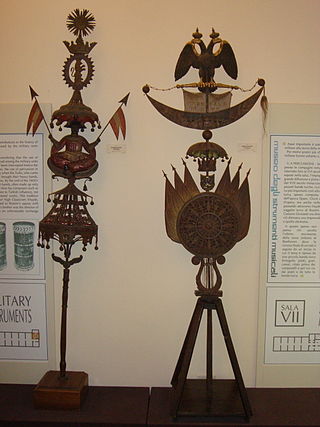
The properties of the Holy See are regulated by the 1929 Lateran Treaty signed with the Kingdom of Italy. Although part of Italian territory, some of them enjoy extraterritoriality similar to those of foreign embassies.

Borgo is the 14th rione of Rome, Italy. It is identified by the initials R. XIV and is included within Municipio I.

The Accademia Nazionale di Santa Cecilia is one of the oldest musical institutions in the world, founded by the papal bull Ratione congruit, issued by Sixtus V in 1585, which invoked two saints prominent in Western musical history: Gregory the Great, for whom the Gregorian chant is named, and Saint Cecilia, the patron saint of music. Since 2005 it has been headquartered at the Renzo Piano designed Parco della Musica in Rome.
The culture of music in Rome is intensely active. The venues for live music include:
The Orchestra dell'Accademia Nazionale di Santa Cecilia is an Italian symphony orchestra based in Rome. Resident at the Parco della Musica, the orchestra primarily performs its Rome concerts in the Sala Santa Cecilia.
Parco della Musica is a public music complex in Rome, Italy, with three concert halls and an outdoor theater in a park setting. It was designed by Italian architect Renzo Piano. Jürgen Reinhold of Müller-BBM was in charge of acoustics for the halls; Franco Zagari was landscape architect for the outdoor spaces. Parco della Musica lies where the 1960 Summer Olympic Games were held, somewhat north of Rome's ancient center, and is home to most of the facilities of the Accademia Nazionale di Santa Cecilia.

Marcello Piacentini was an Italian urban theorist and one of the main proponents of Italian Fascist architecture.
Aldo Ferraresi was a celebrated Italian concert violinist and violin pedagogue.
Rengim Gokmen is a Turkish conductor.

The Accademia Nazionale di Santa Cecilia Musical Instruments Museum (MUSA) is the museum holding the instruments collection of musical instruments of the Accademia Nazionale di Santa Cecilia.
Sergio Rendine was an Italian composer of operas, ballets, symphonies, cantatas and chamber music. He worked as a lecturer at the Conservatorio Alfredo Casella, for the Accademia Nazionale di Santa Cecilia, and for SIAE. He was artistic director of the Teatro Marrucino in Chieti from 1997 to 2007. He received awards for Alice, a "radiophonic opera". His opera Un segreto d'importanza was premiered by the Opéra de Monte-Carlo. His Missa de beatificatione in onore di Padre Pio da Pietrelcina, a mass written for the beatification of Pio of Pietrelcina, was premiered in 1999 in Vatican City, with José Carreras as a soloist. His oratorio Passio et Ressurrectio was recorded live and broadcast from the cathedral in Chieti premiere, and his two symphonies were recorded by Chandos Records.
Filippo Maria Bressan is an Italian conductor.
Lucio Gregoretti is an Italian composer. He composed stage operas, symphonic and chamber music, electro-acoustic music, as well as incidental music for theatre plays, musical comedies, and film scores.

Rocco Filippini was a Swiss classical cellist.
Luca Canonici is an Italian opera singer who has had an active career singing leading tenor roles both in Europe and his native Italy.
The Orchestra Mozart or Orchestra Mozart Bologna is an Italian orchestra based in Bologna.

Paolo Restani is an Italian classical pianist.
Mariangela Vacatello is an Italian classical concert pianist from Naples.

The Teatro Flavio Vespasiano is the main theatre and opera house in Rieti. It was opened on 20 September 1893, after ten years of work and finishing touches; directed by architect Achille Sfondrini. It takes its name from the Roman emperor Titus Flavius Vespasian who was born in sabina.

The Italian Navy Band is an Italian military band based in Rome which serves under the Italian Navy. The band was established in 1870 in La Spezia and is one of the oldest Italian military band units in the Italian Armed Forces. In 1965, it was transferred to Taranto before it was finally relocated to Rome in 1991. The band conducts concerts both in Italy and abroad, performing for international audiences as well as performing for charity, as is in the case of the concert held in 2004 at the International Center for Peace among the Peoples of Assisi. Common Italian venues the band performs in includes the Milan Auditorium, the Accademia Nazionale di Santa Cecilia, the Parco della Musica, and the Teatro di San Carlo. The band is currently composed of a conductor, a vice conductor, an archivist, as well as 102 NCO musicians drawn from music universities all over the country.









